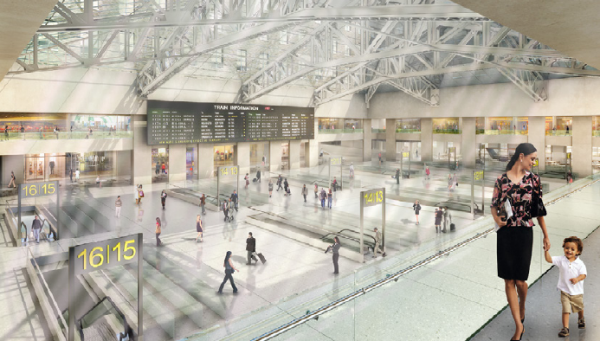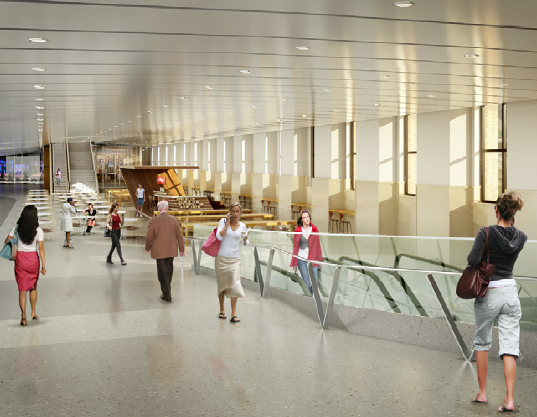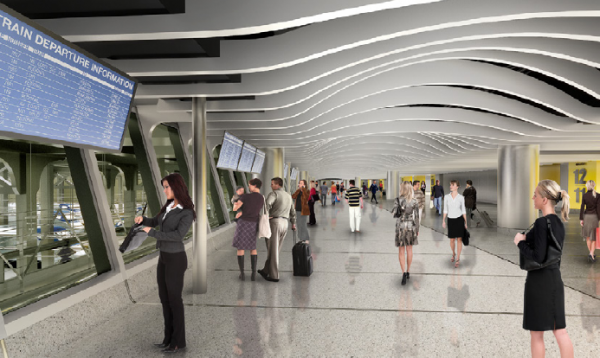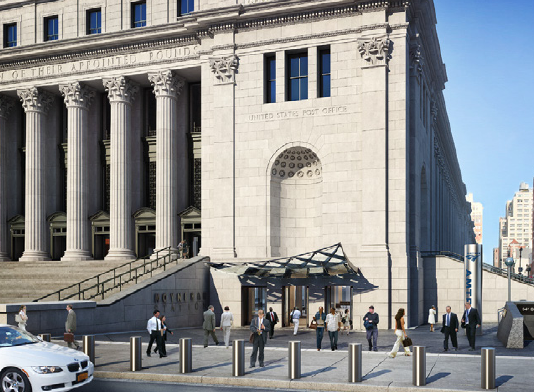Happening Now
Amtrak updates bold, 30-year vision for the Northeast Corridor
July 11, 2012
Written By Sean Jeans Gail

Amtrak released its Vision for the Northeast Corridor: 2012 Update Report this week, providing insight into the current state of planning and development on the Northeast Corridor. The vision paints a tantalizing picture of being able to catch a train in a beautifully renovated Moynihan Station in New York City, and disembarking at Philadelphia’s 30th Street Station within 37 minutes, or Washington, D.C. within 94 minutes.
Amtrak estimates the improvements would cost $115 $151 billion over the next 30 years. There will, however, be a number of capacity and performance milestones enacted before then, including:
- 2015 – 40% increase in Acela capacity
- 2020 – High-speed rail serviced doubled between NYC – Washington
- 2025 – Increased capacity and improved service through NYC, via completion of Gateway Project (new Hudson River rail tunnels)
- 2025 – Improved and expanded service between NYC and Boston, via infrastructure improvements
- 2030 – NextGen service between NYC and Washington (NYC – Philadelphia in 37 minutes, NYC – Washington in 94 minutes)
- 2040 – NextGen service between NYC and Boston (NYC – BOS in 94 minutes)
The plan provides update on the work performed by Amtrak—and other key stakeholders—since 2010’s two major NEC updates. The report also highlights key findings of the recently completed NEC business and financial plan, which finds that the development of Next Generation high-speed rail is eminently achievable through an integrated capital investment program and incremental implementation strategy.
"The NEC region is America's economic powerhouse and is facing a severe crisis with an aging and congested multi-modal transportation network that routinely operates at or near capacity in key segments,” said Amtrak President & CEO Joe Boardman. “With an expected 30 percent population increase by 2050, we must move beyond mere preservation and rehabilitation of the current system to a new vision for expanded transportation capacity and growth.”
Critically, the update provides input for a new NEC environmental analysis and planning process, which will be led by the Federal Railroad Administration (FRA). FRA Administrator Joseph Szabo applauded the plan, which he said will allow the agency to move forward with its review of the plan’s environmental impact on the region:
“On a daily basis, some 2,100 passenger and 50 freight trains use the Northeast Corridor. The FRA is leading a collaborative process involving all of our stakeholders that will produce a comprehensive vision necessary to keep pace with demands of a growing population. The vision we will shape with the Northeast states, Amtrak and all of our stakeholders will outlast the vagaries of politics, budgets, and critics.”
The plan included renderings of what New York City’s Moynihan Station expansion would look like as the hub of a world class passenger rail corridor.



Amtrak’s report is outlined into several broad categories:
NEC Future - FRA Passenger Rail Corridor Investment Plan (PRCIP)
The FRA-led PRCIP will develop a new long-term service plan and related environmental analysis to create a NEC investment plan for the next 30 years. The PRCIP is a critical step in defining and realizing future improvements to the NEC and will provide necessary information to support future FRA investment decisions. It is comprised of two components: a Service Development Plan that articulates the overall scope and approach for future intercity passenger rail service along the NEC and a National Environmental Policy Act (NEPA) programmatic environmental impact assessment that addresses the broad environmental impacts for the entire Corridor along the route of proposed service. It is to be completed in 2015.
Amtrak NEC Capital Investment Program (Program)
Since the release in 2010 of The Northeast Corridor Infrastructure Master Plan and A Vision for High-Speed Rail in the Northeast Corridor, Amtrak has continued its work and has now integrated these two plans into a single, coherent $151 billion service and investment program called the NEC Capital Investment Program. It calls for investments to be made over the coming several decades to improve and expand the NEC, and affirms the Amtrak commitment to implementing critically needed near-term Master Plan projects while advancing the long-term development of a 220 mph (354 kph) NextGen HSR network through incremental "Stair-Step" improvements to its current high-speed rail service (see attached chart).
Amtrak received feedback from states, commuter rail agencies and other NEC users and stakeholders, and has made several changes to its planning since 2010, including: announcement of the Gateway Program to increase track, bridge, station and tunnel capacity from Newark, N.J., to New York Penn Station; a revised alignment of the proposed NextGen HSR route to travel through Providence, R.I., rather than Woonsocket; and changes to various proposed stations.
Amtrak NEC Business and Financial Plan (B&F Plan)
The 2012 Update Report also discusses key findings from the recently completed NEC Business and Financial Plan to guide Amtrak on how to potentially fund and finance its integrated vision for the NEC. Scientifically, the B&F Plan finds greater than anticipated ridership demand for, and associated revenue from, the planned Amtrak services levels supported by the NEC Capital Investment Program, forecasting a 25 percent increase in ridership and revenue over 2010 projections. However, the B&F Plan also finds that the schedule and large annual capital expenditures in the peak period of planned construction should be modified to strengthen opportunities for public and private sector funding, to take into account resource constraints and to ensure effective management and delivery of the Program.
To advance the Program, the B&F Plan concludes that Amtrak should pursue a phased approach and strategically advance specific elements with the biggest impacts on improved reliability, increased capacity and reduced trip-time as quickly as funding allows, while deferring remaining elements to subsequent phases. This approach will help Amtrak achieve early successes that strengthen revenue and financial performance and create additional capital funding to support other Program elements.
For example, the proposed Amtrak Gateway Program to improve travel to and through New York City via new tunnels under the Hudson River and the expansion of the Moynihan Station and Penn Station terminal complex is essential to the entire NEC network. Its completion will deliver many key benefits for intercity and commuter rail service and set the stage for future NextGen HSR expansion.
The B&F Plan also recommends that a combination of funding, policy decisions and cooperation from federal, state, and local governments, NEC users, regional partners, the private sector and Amtrak are necessary to advance a program of this size and regional and national significance. Further, public sector leadership and funding is essential during the early years.
While the B&F Plan finds that current Federal, state, and local transportation investment programs are insufficient to support the Program presently, strategies are available to generate funding, including enhanced access fees paid by NEC users to support state of good repair other improvement projects to the existing corridor that provide the greatest benefits to their services.
Current Amtrak NEC Improvement Projects
Several major projects are now underway that will improve existing services and support the Amtrak NEC vision, including $15 million for Gateway Program planning, design and preliminary environmental review and utility relocation to support construction of a new Portal Bridge in New Jersey, which itself is currently in the final design stage.
Another major ongoing effort is a $450 million project funded by the FRA high-speed and intercity passenger rail program to improve service reliability for intercity and commuter trains, modernize the electrical system and boost top speeds from 135 mph (217 kph) to 160 mph (257 kph) along a 24-mile section of the NEC between Trenton and New Brunswick, N.J. - making it the fastest passenger track in North America. It also will reconfigure track switches at the western entrance to New York Penn Station to mitigate congestion issues. Major construction work is to begin in 2013 with anticipated project completion in 2017.
In addition, Amtrak is nearing the completion of a $140 million project to replace the 104-year old movable Niantic RiverBridge in East Lyme, Conn., to improve reliability, increase speeds on and near the bridge and minimize traffic delays. Rail traffic will begin to shift to the new structure in late summer 2012 with full project completion scheduled for spring 2013.
Next Steps
While initial NEC NextGen HSR studies have been completed, the specific phasing plan, schedule, alignment, stations, and other components analyzed by Amtrak represent the range of possible alternatives and service configurations that could be developed. These concepts and others will undergo considerable scrutiny as the NEC Capital Investment Program continues to be refined by Amtrak and our partners, is considered through the FRA PRCIP process and is subject to extensive future planning and engineering studies.
Boardman stressed "for America to be globally competitive in the coming years, we must be equal to the challenge before us and make the necessary investments to design and implement the NEC improvements that will serve the region and the nation for the century ahead."
"The COVID Pandemic has been and continues to be the biggest challenge faced by Americans as it has taken a deadly toll on the world and on the world’s economies. During COVID Locomotive Engineers at Amtrak and other Passenger and Freight Railroads have embodied the definition of essential workers. This dedication by our members is not new. We applaud the Rail Passenger’s Association for recognizing the vital contributions of our members and their hard work moving Americans and freight during the COVID pandemic."
Dennis Pierce, Brotherhood of Locomotive Engineers and Trainmen (BLET) National President
December 21, 2021, on the Association awarding its 2021 Golden Spike Award to the Frontline Amtrak Employees.
Comments